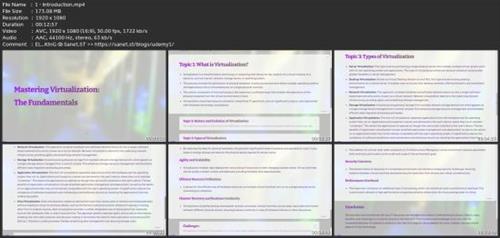Mastering Virtualization: Fundamentals And Best Practices

Published 4/2024
MP4 | Video: h264, 1920x1080 | Audio: AAC, 44.1 KHz
Language: English | Size: 1.88 GB | Duration: 2h 37m
Virtualization Essentials: Hypervisors, Server & Desktop Management, Security
What you'll learn
Learn how virtualization enables multiple OS to run on a single physical machine, optimizing resource use and simplifying IT operations.
Understand the history of virtualization from mainframes to cloud computing, highlighting key technological breakthroughs and their impacts.
Dive into server, desktop, network, and storage virtualization types, exploring how each enhances flexibility, management, and data efficiency.
Grasp the benefits of virtualization, including cost efficiency, agility, disaster recovery, and challenges like management complexity and security.
Requirements
Basic Understanding of Computing and IT Infrastructure: Students should have a foundational knowledge of computer systems, including hardware (servers, storage devices) and software components.
Familiarity with Operating Systems: An understanding of how operating systems work is crucial since virtualization directly involves running multiple OS instances on a single physical hardware platform.
Networking Fundamentals: Knowledge of basic networking concepts and configurations, including LANs, WANs, network topologies, and protocols, is important as virtualization extensively covers network virtualization and its management.
Experience with Command-Line Interfaces: While not always mandatory, familiarity with using command-line interfaces (CLI) can be beneficial, as many virtualization platforms and tools offer CLI for advanced configurations and troubleshooting.
Problem-Solving Skills: The ability to troubleshoot and solve technical problems is essential, as virtualization involves complex scenarios ranging from resource allocation to ensuring high availability and disaster recovery.
Enthusiasm for Continuous Learning: The field of virtualization is constantly evolving, with new technologies and methodologies emerging. Students should be prepared for continuous learning and keeping up-to-date with industry trends.
Description
Take your skills to the next level with our comprehensive course, "Mastering Virtualization: From Fundamentals to Future Trends." Whether you're new to virtualization or a seasoned pro, this course is designed to give you a deep understanding of the technology that's transforming the IT landscape.We'll start with the basics, covering the history and evolution of virtualization, from mainframe partitioning to its role in cloud computing. You'll learn about the different types of virtualization, including server, desktop, network, storage, and application virtualization, and how they can help optimize IT operations, enhance security, and reduce costs.Next, we'll dive into the nitty-gritty of hypervisor technologies, exploring both Type 1 and Type 2 hypervisors and their applications. You'll get hands-on experience installing and configuring hypervisors, creating virtual machines (VMs), and managing virtual networks and storage.We won't stop there. Our course will also cover advanced topics such as high availability, disaster recovery, and the nuances of network and storage optimization within virtualized environments. You'll learn through real-world scenarios and case studies, so you can apply what you've learned in your professional life.By the end of the course, you'll not only have a solid grasp of current virtualization techniques but also be ready to tackle future trends and innovations in virtualization technology. Whether you're looking to enhance your IT career, manage virtualized environments more effectively, or simply curious about the potential of virtualization, this course will give you the knowledge and skills you need to succeed.
Overview
Section 1: Introduction
Lecture 1 Introduction
Section 2: Module 2
Lecture 2 Virtualization Module 2
Lecture 3 Module 2 Self-Guided
Section 3: Module 3
Lecture 4 Virtualization Module 3
Lecture 5 Module 3 Self-Guided
Section 4: Module 4
Lecture 6 Virtualization Module 4
Lecture 7 Module 4 Self-Guided Activities
Section 5: Module 5
Lecture 8 Virtualization Module 5
Lecture 9 Module 5 Self-Guided Activities
Section 6: Module 6
Lecture 10 Virtualization Module 6
Lecture 11 Virtualization Module 6 Self-Guided Activities
Section 7: Module 7
Lecture 12 Virtualization Module 7
Lecture 13 Virtualization Module 7 Self-Guided Activities
Section 8: Module 8
Lecture 14 Virtualization Module 8
Lecture 15 Virtualization Module 8 Self-Guided Activities
Section 9: Module 9
Lecture 16 Virtualization Module 9
Lecture 17 Virtualization Module 9 Self-Guided Activities
Section 10: Module 10
Lecture 18 Virtualization Module 10
Lecture 19 Virtualization Module 10 Self-Guided Activities
Section 11: Module 11
Lecture 20 Virtualization Module 11
Students and Academics: College or university students in computer science, information technology, or related fields who aim to augment their academic knowledge with practical skills in virtualization, which is foundational for careers in cloud computing, data center management, and IT infrastructure.,IT Professionals and System Administrators: Those already working in IT who seek to deepen their understanding of virtualization technologies to improve their skills in managing and optimizing virtual environments. This includes professionals looking to implement or manage virtualized server, desktop, network, or storage solutions.,Tech Enthusiasts and Hobbyists: Individuals with a keen interest in the latest technology trends and practices who want to understand virtualization's role in modern computing environments, including its application in cloud services and the management of virtual networks and devices.,Career Changers: Professionals from other fields looking to transition into IT or computing roles, where understanding virtualization is increasingly considered essential due to its central role in cloud computing and the efficient utilization of IT resources.,Business Decision-Makers and IT Managers: Those responsible for strategizing and making decisions regarding IT infrastructure within organizations, including considerations around cost, scalability, disaster recovery, and security. The course provides the knowledge needed to assess virtualization solutions and their impact on business operations.
Screenshots

rapidgator.net:
https://rapidgator.net/file/c70fd7cd7eb11ddca203b0c14d6a9954/ffwdq.Mastering.Virtualization.Fundamentals.And.Best.Practices.part1.rar.html https://rapidgator.net/file/b68b66119ecc088b66695fc87b8f67cc/ffwdq.Mastering.Virtualization.Fundamentals.And.Best.Practices.part2.rar.html
nitroflare.com:
https://nitroflare.com/view/3DF59B9C8AA3A03/ffwdq.Mastering.Virtualization.Fundamentals.And.Best.Practices.part1.rar https://nitroflare.com/view/C275B5763D380D8/ffwdq.Mastering.Virtualization.Fundamentals.And.Best.Practices.part2.rar